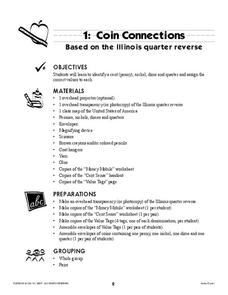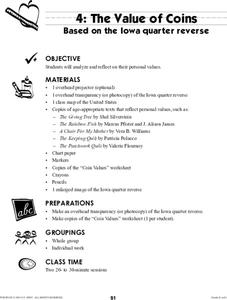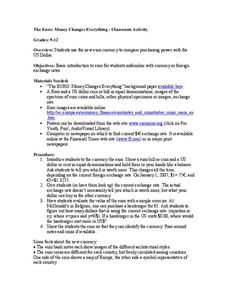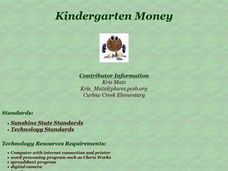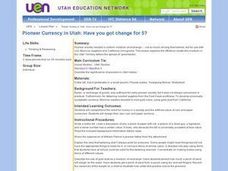Curated OER
Coin Connections
A wonderful lesson on identifying the penny, nickel, dime, and quarter awaits your young mathematicians. They engage in a multi-session lesson which allows them to practice using the values of each coin in worksheets and activities...
Curated OER
Casting Coins
This wonderful art instructional activity invites students to design and “mint” coins bearing their own symbols. A simple carving andcasting process using Blick Wonder-Cut®linoleum and modeling clay is described in the plan. Coins can be...
American Museum of Natural History
Mint Your Own Coin
Provide young archaeologists with an opportunity to craft their own artifacts. The step-by-step directions in an engaging resource show them how to mint their own coin, complete with image, date, and motto.
Curated OER
Show Me The Money
Third graders explore the value of U.S. money. In this money lesson, 3rd graders print out pictures of money from the Internet and create play money. The students will play a game in which they display the amount of money called out by...
Curated OER
Coin Content
Students calculate ancient Greek coin values as compared to their weight, equivalence in grain, and determine their worth today. They explain how to calculate fractions of a given weight and how to use decimal numbers.
Curated OER
The History of Money
In this social studies worksheet, students investigate the history of paper money and coins. Students read paragraphs about what early people used for money and what kinds of banks were used. Students complete a crossword puzzle.
Curated OER
A World of Money
Students explore the traditions related to the creation of national currencies. The role currency plays in shaping a national or regional identity and the influences that the designers of world currency exert are examined in this lesson.
Curated OER
Coin Count Thanksgiving Riddle
In this coin counting worksheet, students count the values for each set by counting the quarters, dimes, pennies, and nickels. Students then write the letters for the coin values to write in the bottom blank to solve the Thanksgiving...
Curated OER
The Value of Coins
Students examine the Iowa state quarter and discuss things they value. They draw a picture of something they value and then practice identifying the values of coins.
Curated OER
Riddle Me Cents!
Students use their creativity and logic skills as well as their knowledge of coin values and history to solve a variety of riddles. The lesson prompts students to compose their own riddles, exchange them with classmates, and solve them.
Curated OER
Get Ready, Get Set, Squeeze!
Students explore coin value and count coin combinations. In this money counting and social studies lesson, students read The Coin Counting Book by Rozanne Lanczak Williams and practice counting money and making change for a lemonade...
Curated OER
Money
Students study the value of the penny, nickel, dime, quarter and dollar. They demonstrate how different coin combinations equal the same amounts of money and write money amounts using the decimal point and dollar sign. They try to...
Curated OER
Money and Business (Art)
Third graders investigate world currency by creating their own coin art. For this government lesson, 3rd graders examine the characteristics of different coins and create their own design for a new one. Students discuss and...
Curated OER
Coin Codes
Learners work on cracking coin codes in honor of the Navajo Code Talkers Medal. Students review the handout on Crack the Code. Learners race to see who can crack the code the fastest.
Curated OER
Introducing money (Elementary, Mathematics)
Students study the penny, nickel, dime and quarter, one each day for four days, using a magnifying glass to identify the similarities. Then students discuss differences and value and learn a 'rap' to memorize values.
Curated OER
It's in Your Pocket
Students examine American coins. In this American currency lesson, students study how American money came to be as well as the responsibilities of the U.S. Mint. Students discover details regarding American coins and design their own coins.
ProCon
Gold Standard
If all the mined gold in the world was melted across a football field, it would rise 5.4 feet. That's just one interesting fact pupils learn when using the debate topics website to determine if the United States should return to a gold...
Curated OER
Math -- Money
Students identify a penny, nickel, dime, quarter and a half dollar. They examine the value of each coin and its equivalents (to quarter/dollar). After pairing up with a classmate, each one drills the other one on each coin.
Curated OER
The Euro: Money Changes Everything
Ninth graders compare the Euro with the purchasing power of the US dollar. In this economic lesson, 9th graders evaluate the value of the Euro through various exercises. Students research the currency exchange rates of the Euro.
Curated OER
Lesson 3: Where Does Money Come From?
Students listen to story Hundred Penny Box by Sharon Bell Mathis, explore history of money, and examine how money is produced in the United States. They discuss why money is used for exchange, and describe how money has changed over time.
Curated OER
Kindergarten Money
Students identify the various coins and their values through presentations, a rubric, a value pretest, and coin manipulatives. Money is incorporated into various activities whether at home or in school. Students create money webs using...
Curated OER
Pioneer Currency in Utah: Have you got change for a 5?
Pupils explore the need for money in a society and the artificial value of coin and paper currencies. They design their own coin and paper currency.
Curated OER
Money Madness
Second graders review coins and their values. In this coin recognition instructional activity, 2nd graders review the coin values as they read 'Smart' by Shel Silverstein. Students use class computer demonstrations to identify the coin's...
Curated OER
Money Booklet
Students practice handling money by examining different world currency. In this economics lesson, students utilize a coin booklet to trace individual coins and draw bills, later coloring them in their traditional colors....
